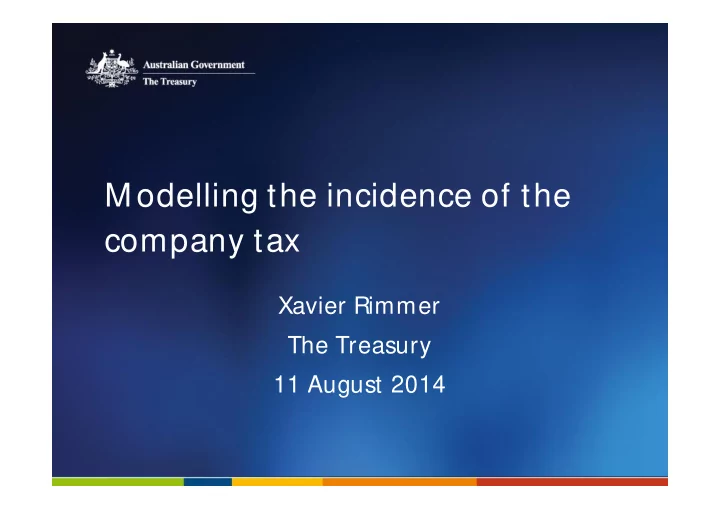

M odelling the incidence of the company tax Xavier Rimmer The Treasury 11 August 2014
Overview • Background • M odel – Overview – Key simplifying assumptions – Limitations • M easures of welfare, efficiency and incidence • Scenarios • Results
Background • Based on Business tax working group work and model development • BTWG Terms of reference – Impacts on national income, looking at § Rate lowering, base broadening scenarios § Focus on long-run economic impacts • Treasury continued to look at the impact of the company income tax
M odel – Overview • Independent Economics (IE) CGE model – Comparative static (long run) model • Tax detail • Detailed domestic economy – Detailed production function – Detailed incorporation of company tax • Partial representation of foreign sector
M odel – Overview, continued • 9 Types of capital – 7 types of reproducible capital – 1 mobile factor in fixed global supply – 1 immobile factor in fixed local supply • Land • Labour
M odel – Key simplifying assumptions • Foreign investors finance all capital expansion – Fixed ownership of domestic capital stock • Exogenous required after tax rate of return – Foreign capital enters/ leaves until the domestic after tax rate of return equals the globally required rate
M odel - Limitations • Long-run model – No transitional effects of changes • Small open economy assumption (partial foreign sector) means we cannot properly examine the response of foreigners – Foreigners receive windfall gain from increased return to fixed factors – However, movement of consumption to/ from Australian exports over states the welfare effect
M easures • This analysis requires a range of measures of the impact of taxes, chiefly: – Household welfare § Full-consumption [= consumption plus leisure valued in consumption units] – Excess burden § Efficiency of tax – Economic incidence § Distribution of impact
M easures S P P * D Q * Q
M easures S’ S P P C P * P P D Q * Q’ Q
M easures - excess burden S’ S P P C P * P P D Q * Q’ Q
M easures - incidence S’ S P P C P * P P D Q * Q’ Q
Scenarios • M easuring the incidence of a 1 percentage point reduction in the company tax rate • 3 versions of the model to test the sensitivity of results to the existence of: – Economic rents – Imperfect capital mobility
Results • Declining domestic capital income – – • Rising labour income – – • Ambiguous leisure effect –
Scenarios Scenario Economic rents Perfect capital mobility Open and competitive ß � economy � � Economic rent (main) � ß Imperfect capital mobility
Results – Excess burden Open and Imperfect capital $m 2011-12 Economic rents competitive mobility Change in household welfare 1,035 509 421 Change in government revenue -615 -915 -994 Marginal excess burden 168% 56% 34%
Results – M acro impacts Per cent Per cent 0.5 0.5 Headline indicators 0.4 0.4 0.3 0.3 0.2 0.2 0.1 0.1 0.0 0.0 Capital stock Employment Real wage Exchange rate GDP Consumption Household welfare Open and competitive Economic rents Imperfect capital mobility
Results – Incidence Domestic welfare change Open and Imperfect capital Economic rents ($m 2011-12) competitive mobility Domestic Leisure -510 -333 -284 Labour & lump sum transfers 2026 668 289 Capital income -481 174 333 Household full consumption 1035 509 337 Foreign Fixed factors 202 223 207
Results – Incidence Domestic welfare change Open and Imperfect capital Economic rents ($m 2011-12) competitive mobility Leisure -510 -333 -284 Consumption 1545 842 622 Labour & lump sum transfers 2026 668 289 Capital income -481 174 333 Variable capital -913 -790 -566 Fixed factors 432 964 899 Household full consumption 1035 509 337
Recommend
More recommend